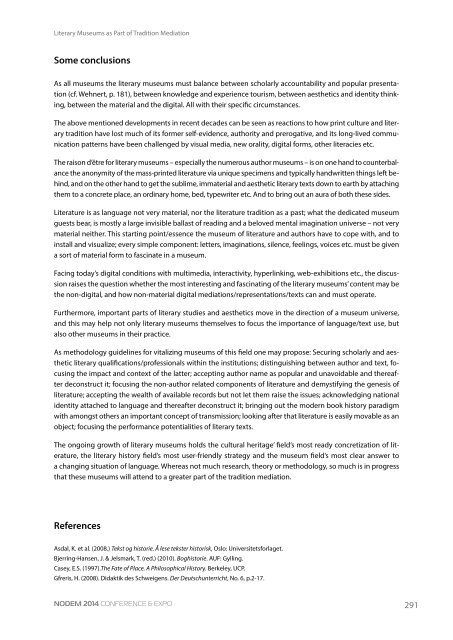NODEM 2014 Proceedings
NODEM 2014 Proceedings
NODEM 2014 Proceedings
You also want an ePaper? Increase the reach of your titles
YUMPU automatically turns print PDFs into web optimized ePapers that Google loves.
Literary Museums as Part of Tradition Mediation<br />
Some conclusions<br />
As all museums the literary museums must balance between scholarly accountability and popular presentation<br />
(cf. Wehnert, p. 181), between knowledge and experience tourism, between aesthetics and identity thinking,<br />
between the material and the digital. All with their specific circumstances.<br />
The above mentioned developments in recent decades can be seen as reactions to how print culture and literary<br />
tradition have lost much of its former self-evidence, authority and prerogative, and its long-lived communication<br />
patterns have been challenged by visual media, new orality, digital forms, other literacies etc.<br />
The raison d’être for literary museums – especially the numerous author museums – is on one hand to counterbalance<br />
the anonymity of the mass-printed literature via unique specimens and typically handwritten things left behind,<br />
and on the other hand to get the sublime, immaterial and aesthetic literary texts down to earth by attaching<br />
them to a concrete place, an ordinary home, bed, typewriter etc. And to bring out an aura of both these sides.<br />
Literature is as language not very material, nor the literature tradition as a past; what the dedicated museum<br />
guests bear, is mostly a large invisible ballast of reading and a beloved mental imagination universe – not very<br />
material neither. This starting point/essence the museum of literature and authors have to cope with, and to<br />
install and visualize; every simple component: letters, imaginations, silence, feelings, voices etc. must be given<br />
a sort of material form to fascinate in a museum.<br />
Facing today’s digital conditions with multimedia, interactivity, hyperlinking, web-exhibitions etc., the discussion<br />
raises the question whether the most interesting and fascinating of the literary museums’ content may be<br />
the non-digital, and how non-material digital mediations/representations/texts can and must operate.<br />
Furthermore, important parts of literary studies and aesthetics move in the direction of a museum universe,<br />
and this may help not only literary museums themselves to focus the importance of language/text use, but<br />
also other museums in their practice.<br />
As methodology guidelines for vitalizing museums of this field one may propose: Securing scholarly and aesthetic<br />
literary qualifications/professionals within the institutions; distinguishing between author and text, focusing<br />
the impact and context of the latter; accepting author name as popular and unavoidable and thereafter<br />
deconstruct it; focusing the non-author related components of literature and demystifying the genesis of<br />
literature; accepting the wealth of available records but not let them raise the issues; acknowledging national<br />
identity attached to language and thereafter deconstruct it; bringing out the modern book history paradigm<br />
with amongst others an important concept of transmission; looking after that literature is easily movable as an<br />
object; focusing the performance potentialities of literary texts.<br />
The ongoing growth of literary museums holds the cultural heritage’ field’s most ready concretization of literature,<br />
the literary history field’s most user-friendly strategy and the museum field’s most clear answer to<br />
a changing situation of language. Whereas not much research, theory or methodology, so much is in progress<br />
that these museums will attend to a greater part of the tradition mediation.<br />
References<br />
Asdal, K. et al. (2008.) Tekst og historie. Å lese tekster historisk, Oslo: Universitetsforlaget.<br />
Bjerring-Hansen, J. & Jelsmark, T. (red.) (2010). Boghistorie. AUF: Gylling.<br />
Casey, E.S. (1997).The Fate of Place. A Philosophical History. Berkeley, UCP.<br />
Gfreris, H. (2008). Didaktik des Schweigens. Der Deutschunterricht, No. 6, p.2-17.<br />
<strong>NODEM</strong> <strong>2014</strong> Conference & Expo<br />
291


